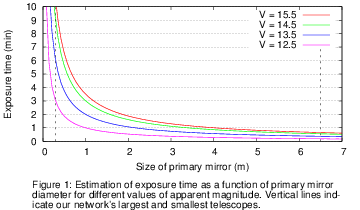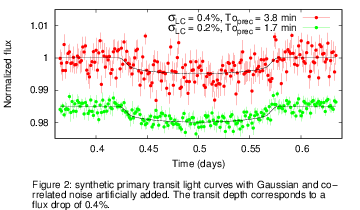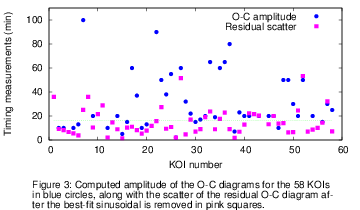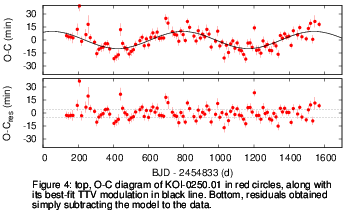 |
In order to effectively distribute the available telescope time and to maximize the
overall timing precision, three main characteristics have to be considered: the
aparent magnitude of the star, the size of the primary mirror, and the amplitude
of the O-C diagram.
With the main goal to connect the KOIs to their most suitable telescopes,
we proceeded as follows: first,
we estimated the exposure time et for each star and telescope. This calculation was
carried out considering parameters such as the mean seeing of the site, the brightness
of the star, the desired signal-to-noise ratio, the size of the primary mirror, typical
sky brightnesses, and the phase of the Moon and the altitude of the star during predicted
observing windows, among others. We
compared this estimations to real astronomical data, simply contrasting the exposure time,
the size of the primary mirror, and the magnitude of the observed star obtained from the
bibliography against our estimated cadence. Figure 1 shows our results, where the exposure
time has been approximated with a power law of the telescope's diameter.

|
It is well known that off-transit data have a huge impact in the determination of the
orbital and physical parameters of any transiting system. In the case of ground-based observations,
off-transit data are critical to remove systematics such as airmass, color-dependent extinction,
and poor guiding, among many others. Henceforth, to determine the number of data
points N per transit we used the estimated exposure time and the
known transit duration Tdur incremented by two hours. This increment accounts for 1 hour
of off-transit data before and after transit begins and ends, respectively. Then, the number of data
points N per transit was simply estimated as follows:
N = (Tdur + 2)/et.
To estimate the timing precision σT we used a variant of the formulism provided by
Ford & Holman (2007):
| σT = [Photprec Tdur] / [N0.5 2 Tdepth], |
where Tdepth is the transit depth, and Photprec is the photometric precision
that a given telescope can achieve while observing a 14-15 Kmag star. This value was
inquired to the members of KOINet at the beginning of the network's organization.
Comparing the estimated timing precision with the semi-amplitude
of the O-C diagrams AO-C (AO-C > 3σT) jielded erroneous
results, specially if the TTV was large (several hours). By instance, if the timing precision is
determined as 1 hour, compared to a TTV amplitude of 3 hours the relation
would be satisfied. But a timing precision of 1 hour is not only unrealistic but useless. Therefore,
three aspects were simultaneously considered. Only if all of them where satisfied, then the KOI
was assigned to the telescope. The aspects are the transit depth, the scatter of the O-C diagram, and
its amplitude.
1) The transit depth is extremely relevant. Therefore, the first condition requires
it to be larger than 75% the photometric precision that a given telescope can achieve
observing Kepler kind-of stars, Tdepth > 0.75 Photprec.
To arrive to this value we made use of synthetic data: First,
a primary transit light curve with duration comparable to a "normal" observing run (~6 hours) was
produced. To this end, we made use of
Mandel & Agol (2002) primary transit
model.
Then, white and correlated noise with amplitude comparable to Photprec was added.
The cadence of the synthetic data was set to 3 minutes. Once the light curve was generated, the
mid-transit time, semi-major axis, orbital inclination and transit depth were fitted to the synthetic
data.
Since Kepler light curves will provide accurate orbital parameters, this analysis will return
overestimated error bars. This is in good agreement with our conservative approach. Figure 2 shows
two synthetic primary transit light curves. The mean scatter of the data was set to 0.4% for the red
one and 0.2% for the green one. In both cases the transit depth was set to 0.4%.
To obtain the parameter estimates and
their errors we have sampled from the posterior probability distribution using a Markov-chain Monte
Carlo approach. For the fitted parameters we defined uniform priors covering a reasonable range.
After 106 iterations and an initial burn of 105, the timing accuracy was obtained
to be between 3 and 4 minutes for the red light curve and less than 2 minutes for the green one.

|
The previously mentioned limit between photometric precision and transit depth
(i.e., Tdepth > 0.75 Photprec) was obtained lowering the photometric precision
of the synthetic light curves until a timing precision of 5 minutes was reached. This upper limit is
considered to be competitive with Kepler timing precision and, for some cases, even better.
For this analysis transit depths between 1% and 0.1% were considered.
2) Closely analyzing the O-C diagrams we noticed that the computed amplitude was sometimes comparable
to its scatter. This can be observed in Figure 3, where
the amplitude of the observed TTVs (AO-C) plotted in blue circles
is compared to the scatter of the residual O-C diagram (pink squares) after the TTV variation was
removed.

|
To better illustrate this we made use of a real system: KOI-0250. The top panel of Figure 4 shows the
mid-transit times of the
17 quarters of Kepler data, overplotted with the best-fit sinusoidal modulation. The TTV amplitude
was computed to be around 10 minutes. The bottom panel of the same Figure shows the residual timings
once the TTV modulation was removed. In this case, the scatter of the residuals is comparable to the
TTV amplitude. Since the errors of the individual mid-transit times could be underestimated (this is
usually the case when systematic effects are not properly considered) we think a more conservative
approach to consider the scatter of the residuals as overall timing precision. Since the O-C
diagrams showing this behavior can return a proper dynamical description of a planetary system,
our second condition relates the O-C amplitude and the timing precision as follows:
AO-C > σT.

|
3) Following the line of thought of Point 2), the third condition relates the scatter of the residual
O-C diagrams σKepler with the derived timing precision:
2σKepler > σT.